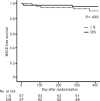Effects of deferred versus immediate stenting on left ventricular function in patients with ST elevation myocardial infarction
- PMID: 34260542
- PMCID: PMC8284705
- DOI: 10.1097/MD.0000000000026598
Effects of deferred versus immediate stenting on left ventricular function in patients with ST elevation myocardial infarction
Abstract
Background: Previous studies have shown conflicting results on the benefits of deferred stenting (DS) in infarct size and the incidence of microvascular obstruction in patients with ST elevation myocardial infarction (STEMI). However, effect of DS on left ventricular (LV) function was not known. We aimed to evaluate whether DS improve LV function and relevant clinical outcomes after STEMI, using follow-up data from the INNOVATION study (NCT02324348).
Methods: In total, 114 patients were randomly assigned to DS group or immediate stenting (IS) group at a 1:1 ratio. LV functional remodeling indices and MACE (major adverse cardiac events: a composite of death, non-fatal MI, unplanned target vessel revascularization, or hospitalization due to heart failure) were compared between DS and IS groups.
Results: Serial echocardiographic analyses were completed in 89 subjects (78%). There were no significant changes in LV volume in either group. While LV ejection fraction and wall motion score index (WMSI) improved in both groups during follow-up, the increments were not statistically different between the 2 groups (4.3 ± 8.2 vs 3.2 ± 7.1, P = .504 for ΔLV ejection fraction; -0.16 ± 0.25 vs -0.16 ± 0.25, P = .99 for ΔWMSI). However, E/e'' was decreased and e' was increased only in the DS group (-3.31 ± 5.60 vs -0.46 ± 3.10, P = .005 for ΔE/e'; 0.77 ± 1.71 vs -0.22 ± 1.64, P = .009 for Δe'). The incidence of major adverse cardiac events was numerically lower in the DS group than in the IS group without a statistical significance at 1-year follow-up.
Conclusions: Routine DS improved LV diastolic function but not systolic function compared with IS in patients with STEMI.
Copyright © 2021 the Author(s). Published by Wolters Kluwer Health, Inc.
Figures



References
-
- Ndrepepa G, Tiroch K, Fusaro M, et al. . 5-year prognostic value of no-reflow phenomenon after percutaneous coronary intervention in patients with acute myocardial infarction. J Am Coll Cardiol 2010;55:2383–9. - PubMed
-
- Svilaas T, Vlaar PJ, van der Horst IC, et al. . Thrombus aspiration during primary percutaneous coronary intervention. N Engl J Med 2008;358:557–67. - PubMed
-
- van Kranenburg M, Magro M, Thiele H, et al. . Prognostic value of microvascular obstruction and infarct size, as measured by CMR in STEMI patients. JACC Cardiovasc Imaging 2014;7:930–9. - PubMed
-
- Niccoli G, Burzotta F, Galiuto L, Crea F. Myocardial no-reflow in humans. J Am Coll Cardiol 2009;54:281–92. - PubMed
Publication types
MeSH terms
Associated data
LinkOut - more resources
Full Text Sources
Medical

